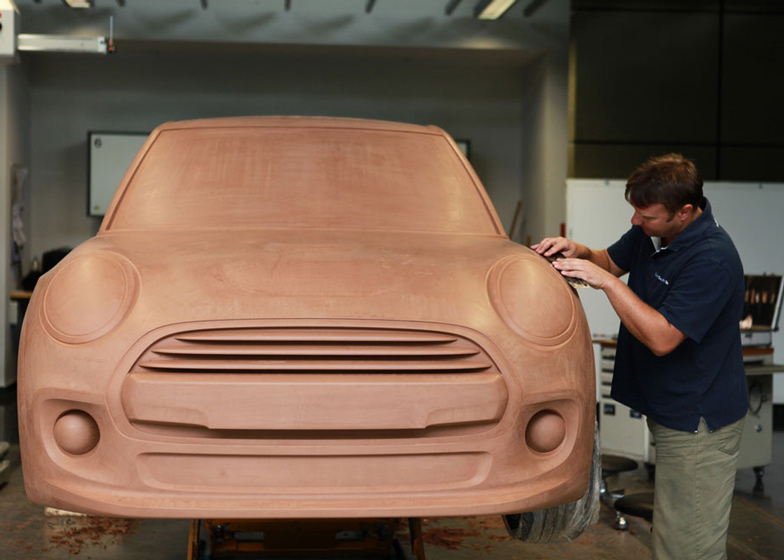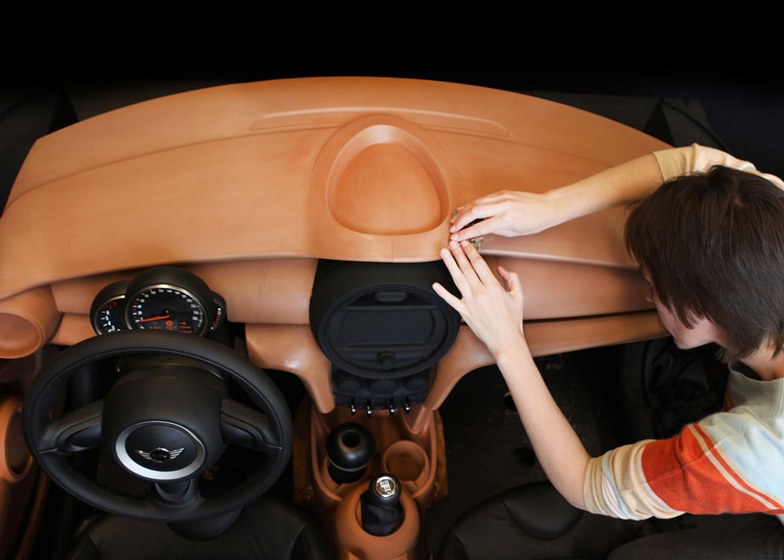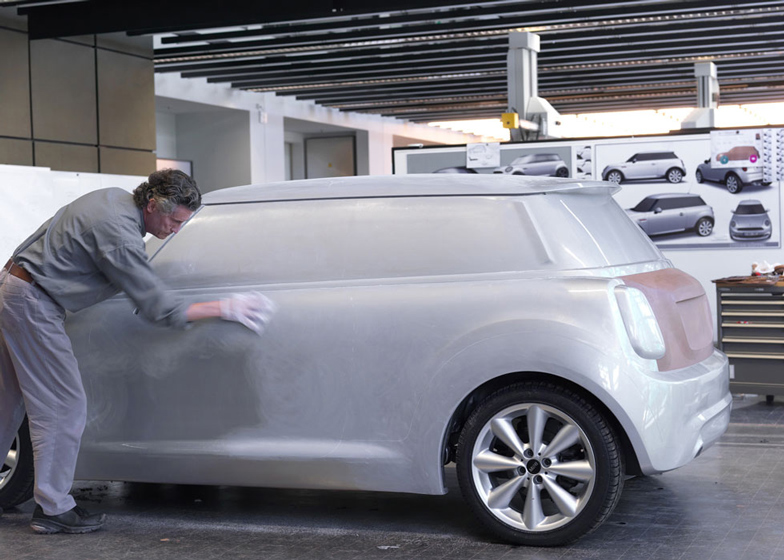Interview: the designer of the original 1959 MINI "would have a lot of respect for the cleverness" of the latest incarnation of the car, according to Adrian van Hooydonk, head of design at MINI parent company BMW Group (+ slideshow + interview).
"I think he would simply be happy that MINI as a brand is alive and kicking today," Van Hooydonk told Dezeen at the global launch party for the new MINI, held in London last night. "He probably would not have imagined that in his wildest dreams."
The launch was held on what would have been the birthday of Greek-born engineer Alec Issigonis, who was born in 1906 and died in 1988.
"I think he would have a lot of respect for the cleverness of the engineering," said van Hooydonk. "I think he would also respect us for being such a custodian of the original idea. Doing a car that is as compact as this in today's world is actually quite an achievement."
The car was originally launched in 1959 by UK conglomerate British Motor Corporation, with Issigonis' compact design, which featured a revolutionary space-saving transverse engine, remaining on sale more or less unchanged until 2000.
The iconic British marque was acquired by German car brand BMW Group in 1994 and relaunched in 2001. Yesterday's launch is the second major overhaul of the car since then.
"I think it has worked out very well," said van Hooydonk of the acquisition. "BMW has been very respectful of MINI's history."
The new-look MINI is longer, wider and taller than its predecessor, partly due to modern safety regulations, van Hooydonk said. "I think the MINI is the most compact vehicle that any car company can do today because the safely requirements have become much tougher."
The new car takes many design cues from the 1959 original, including short overhangs, round headlights and an enlarged front grille.
"[The grille] is now larger; it still has a MINI typical shape and it now refers to the MINI Mark 1, which also had a very large front," van Hooydonk explained. "The headlamps and tail lamps are still referring to the iconic shapes but they are now packed with very modern LED technology."
"To make a MINI recognisable as a MINI, you need to use full surfaces; rounded surfaces," he continued. "But we've added sharp lines so the overall effect is one of a crisper car. I feel it’s a tighter car so the perception of quality and the actual building quality have gone up."
The new MINI was developed by MINI head of design Anders Warming under the guidance of van Hooydonk. The car features a new platform, which it will share in future with a new generation of BMWs.
Van Hooydonk said that BMW Group investigated sharing the MINI platform with other car brands to save costs but in the end decided to develop the platform themselves. "We simply found that no one was able to do compact cars like MINI do," he said. "Nobody had a package or the proportions that we need to do a MINI, so we decided to do it on our own. "
Here's an edited transcript of the interview:
Marcus Fairs: It’s 19 years since BMW Group bought MINI and 12 years since the car was first relaunched. How has the marriage between a German corporation and a British marque worked out?
Adrian van Hooydonk: I think it has worked out very well. Of course it needed a Dutch guy in between to sort of translate…
Marcus Fairs: And a Danish guy [MINI head of design Anders Warming]?
Adrian van Hooydonk: And a Danish guy. It needs some neutral elements from small countries that have no car industry to make ends meet. BMW Group actually did very well because I think it was a decision with a lot of foresight, to keep hold of MINI, because I think people are going to look for smaller cars in the future.
People want cars that have a strong character. People don't want boring cars. It’s perfectly set up for years to come. BMW has been very respectful of MINI's history and the same is true for Rolls Royce [which BMW Group bought in 1998] so I think that’s been part of the success story. This is why MINI is still here today.
Marcus Fairs: What’s new about the new MINI?
Adrian Van Hooydonk: Well of course to make a MINI recognisable as a MINI, you need to use full surfaces; rounded surfaces. But we've added sharp lines so the overall effect is one of a crisper car. I feel it’s a tighter car so the perception of quality and the actual building quality have gone up.
On the front, we have redesigned the grille. It is now larger; it still has a MINI typical shape and it now refers to the [1959] MINI Mark 1, which also had a very large front. The headlamps and tail lamps are still referring to the iconic shapes but they are now packed with very modern LED technology. It has daytime running lights so you will be able to recognise the MINI day and night.
In the interior, the level of luxury has gone up considerably and it’s packed with very clever technology as well like internet connectivity and a heads-up display that you will see the most relevant navigation on. So I think we have upgraded the new car both inside and out while retaining this friendliness that MINI stands for.
Marcus Fairs: It’s also bigger. MINI is not such a small car any more. Why is MINI getting bigger?
Adrian van Hooydonk: I used to own and drive an original MINI when I was a little bit younger. I actually fitted in that car and I have to say I had one accident with that car; it was written off completely. I was happy that I got away unharmed and that answers your question pretty much. I think the MINI is the most compact vehicle that any car company can do today because the safely requirements have become much tougher and I think this is a good thing.
MINIs today are very safe and are filled with airbags and are designed and engineered to face things that our customers never want to experience. But I think any MINI will always be the most compact offering in its segment.
Marcus Fairs: What about the platform [the chassis and other major engineering components]?
Adrian Van Hooydonk: We developed a completely new platform, not just for this MINI, but the MINI was the lead car for this set of mechanicals. It will also lead to some new BMWs; some front-wheel drive BMWs. We looked at working with other brands to share the platform but in the end we developed this platform from scratch on our own.
We set the parameters in terms of proportions. As a design team, we were able to get the proportions for the new MINI just the way we wanted it, with very short overhangs. It’s a very compact vehicle; it’s slightly wider than the previous car. What is good for MINI will also be good for BMW later on.
Marcus Fairs: Why did you want to work with other car brands and why did that not happen in the end?
Adrian Van Hooydonk: If you are able to work on an architecture that will lead to, let’s say, twenty vehicles or so, that will give you some economy of scale. Our customers are prepared to pay a premium but that’s not unlimited. So we need to find a way to make it affordable and do more cars.
Doing one type of architecture will allow you to do that but as we scanned the industry, we simply found that no one was able to do compact cars like MINI do. Nobody had a package or the proportions that we need to do a MINI, so we decided to do it on our own.
Marcus Fairs: So this will lead to a new type of BMW based on this shared platform? Will BMWs and MINIs share other parts?
Adrian van Hooydonk: We have already shown a concept car called the Active Tourer, which will be a new type of BMW that will launch in the near future, which will also have front wheel drive. But if you know the concept car, then you will see that it looks completely different. Not even the gearshift or any button or any element from the MINI will be carried over to the BMW. It’s all happening underneath the skin; so in some suspension parts or mechanical parts where we were then able to get some economy of scale [there are shared parts] whilst keeping the brand identity of MINI and BMW very pure.
Marcus Fairs: BMW is now positioning itself as a mobility solutions provider rather than a car brand. It’s about helping people make mobility choices rather than simply selling them cars. How does that translate to MINI, which is a fun, urban brand?
Adrian van Hooydonk: That’s a very good question. MINI is a very urban brand so it’s designed for people who live in the city; people who lead a very active life. You can tell from looking at a MINI that the people that drive it like to enjoy life. MINI is not as serious as many of the car brands out there.
I think new mobility would fit the MINI brand. As it stands, the MINI product line-up actually uses far less fuel than the BMW brand does. So far, we don't feel there's an immediate lead to electrify a MINI; also a smaller car is a little harder to do.
We are launching a whole new brand, BMWi, to deal with that identity and we went a long way towards achieving zero emissions, making the car out of carbon fibre with the i3 [electric car] or reinventing the sports car with the 8 [plug-in hybrid concept car]. We learned a lot from those projects and that knowledge will certainly filter back into both the MINI brand and the BMW.
Marcus Fairs: If Alec Issigonis, who designed the original MINI, was to see the new MINI, what would he say?
Adrian van Hooydonk: He would probably say, in all honesty, that a lot of design has gone on, knowing that he wasn't a designer - he was an engineer. I think the same is true for all products in the world today. I think he would have a lot of respect for the cleverness of the engineering. I think he would also respect us for being such a custodian of the original idea.
Doing a car that is as compact as this in today's world is actually quite an achievement. I think he would simply be happy that MINI as a brand is alive and kicking today. He probably would not have imagined that in his wildest dreams.
Marcus Fairs: What’s the relationship between your design team at BMW Group and Anders Warming and his team at MINI? Is the new MINI their design or yours?
Adrian van Hooydonk: It’s his team’s design and we are more than colleagues, we are friends. He started a little bit later than I did in the company but we worked together in Design Works, [BMW Group’s] Californian studio. Now we are both in a position that we can give a direction to whole brands.
I like to give the design teams a lot of freedom. If there is a disagreement then that’s okay because people have different opinions about design. If they have no opinion or they start agreeing with me, that would be the moment that I would start worrying.
I know that Anders is an extremely talented designer because I've seen him sketch and I've seen him grow. And I know that he works the same way that I do. I feel very privileged to now have guys like him in charge of each of the brands that I lead. It makes my life easier and more rewarding, working with people like him.
Marcus Fairs: What’s the next step?
Adrian van Hooydonk: Well today we've just launched the new core car. It’s the anchor for the brand so you have to be respectful and careful. Now for the next cars that you'll see coming from MINI are around the core cars. I think you can expect each of these cars to move away from the core cars slightly: more distinct identities for the other products, a little bit more about today's MINI family which is very closely related we feel, to the core car. We want it to really grow as a family.
Marcus Fairs: What kind of family are you talking about?
Adrian van Hooydonk: Well that’s a question that I'm not really at liberty to answer now. You know that today the MINI family consists of seven cars. We are still investigating what the family will consist of. But the new family members that will come out will have more of a stand-alone character. You will recognise them as part of the MINI family, but each of them will have a more distinct character of their own which I think is the next step for the MINI brand.

















